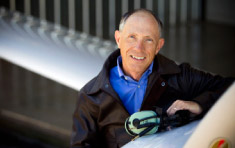 About a year ago we discussed how general aviation is an ecosystem and that our phenomenal airport system would begin to collapse if the number of pilots didn’t increase. If the plankton (light aircraft) die off, the whales (turbine aircraft) will have far fewer places to go, and their value equation diminishes greatly. The industry spends way too much effort focused on aircraft and equipment the majority of pilots or aspiring pilots will never be able to afford.
About a year ago we discussed how general aviation is an ecosystem and that our phenomenal airport system would begin to collapse if the number of pilots didn’t increase. If the plankton (light aircraft) die off, the whales (turbine aircraft) will have far fewer places to go, and their value equation diminishes greatly. The industry spends way too much effort focused on aircraft and equipment the majority of pilots or aspiring pilots will never be able to afford.
Legend has it that bank robber Willy Sutton said he robbed banks because that’s where the money was. That would seem to be a great business strategy and, in the short term, it’s true. But if a business only chases dollars, it eventually will decline, because the true purpose of any business is to serve customers—not just make money. It’s a subtle and vitally important difference. The money naturally follows, but too often management’s emphasis is misplaced to feed the shareholders.
Most will agree that we generally pay too much for aircraft and associated items, but there are some solutions—and I’m so proud that AOPA and the AOPA Foundation have arrived in the right place. For example:
Multiple fly-ins all over the country allow pilots who never could come to just one big annual extravaganza (Summit/Expo) to experience a great aviation event. The numbers speak for themselves, with more than 15,000 attendees this year—many who had never been to a national AOPA gathering.
You Can Fly program (Cessna 150/152 Reimagined). The yellow aircraft that are being remanufactured from the wheels up and sold by Aviat Aircraft serve as a new alternative for clubs and flight schools (“Meet Your New 152,” page 58). The numbers are compelling: Base cost under $100,000. Spread between 10 or so owners and burning about five gallons an hour, the hourly operating cost is about $65. The 150 and 152 taught generations of pilots to fly, and they do the job extremely well. AOPA will offer special financing and insurance packages to keep acquisition and operating costs low.
Government rollback. Will Rogers said that it’s good we don’t get all the government we pay for. In far too many places we’re paying for regulation and oversight that adds little or nothing to safety or efficiency. In the quest for the perfect solution to make GA as safe as the airlines, new technology and cost-effective solutions are blocked. AOPA is leading industry efforts on the medical reform program and on the Part 23 rewrite.
Safe pilots, safe skies. Accidents are extremely expensive to all of us in terms of litigation, regulation, negative public perception, and insurance. Severe injury and the loss of life are beyond calculation. Fact: GA, as a group, cannot get to the air carrier safety level, for a variety of reasons that I’ve written about before. But, over the past 20-plus years that I’ve had the honor to lead the AOPA Air Safety Foundation and now the Air Safety Institute, we’ve invested tens of millions of donor dollars, conducted thousands of free safety seminars, trained tens of thousands of CFIs, and produced countless publications. The accident numbers are gradually getting better, and the educational materials and programs are constantly improving. Your flight operation is as safe as you chose to make it.
All this has significant potential, but it doesn’t just happen. It takes time and resources to fight these battles. It bears repeating that our AOPA dues alone do not begin to cover all the expense of protecting your freedom to fly—but that’s exactly what’s at stake. Fewer than six percent of AOPA members make a tax-deductible contribution to the AOPA Foundation to help in the various areas listed above to preserve our ecosystem.
In my final request as president of the AOPA Foundation, I ask that you join me—this year, right now—to make a contribution at whatever level you can reasonably afford. If every member made an annual gift of just $50, it would make a huge difference in our ability to start taking back the skies. In my semi-retirement I look forward to working in several of these areas. As a new first-time aircraft owner it’s absurd to me that a static wick should cost somewhere between $40 and $130. Don’t even ask about batteries!
Jim Minow, who is capably taking the position as the executive director of the AOPA Foundation, is tasked with funding the operation and moving us to the flight levels. Please help him. I will look forward to enjoying your company at various aviation events to discuss safety and operations. General aviation has been a huge part of my life and if we’re going to enjoy it going forward, the ecosystem has to be preserved so plankton and whales alike can flourish.
Bruce Landsberg retires from the AOPA Foundation this month after serving AOPA members for more than 20 years.



